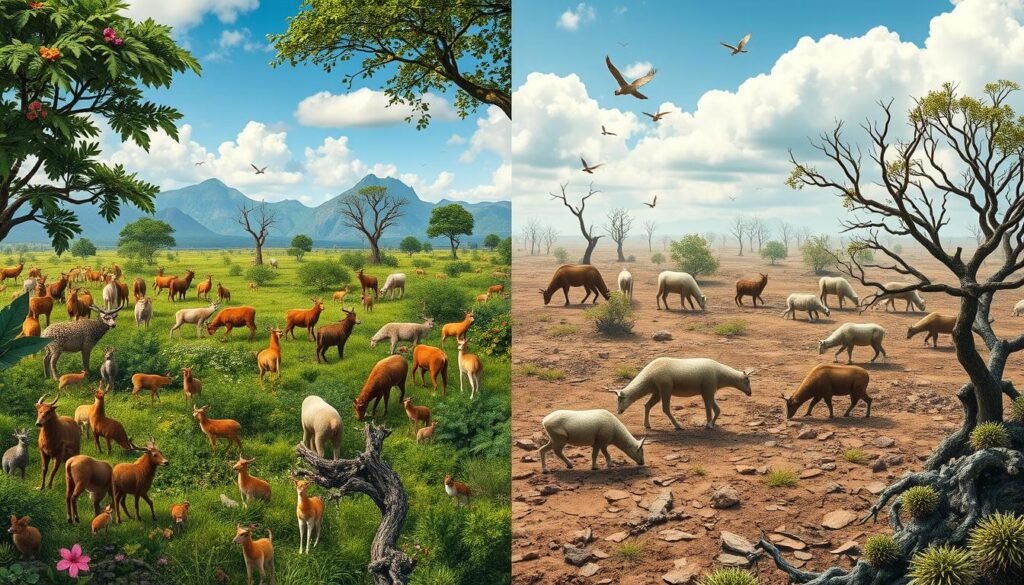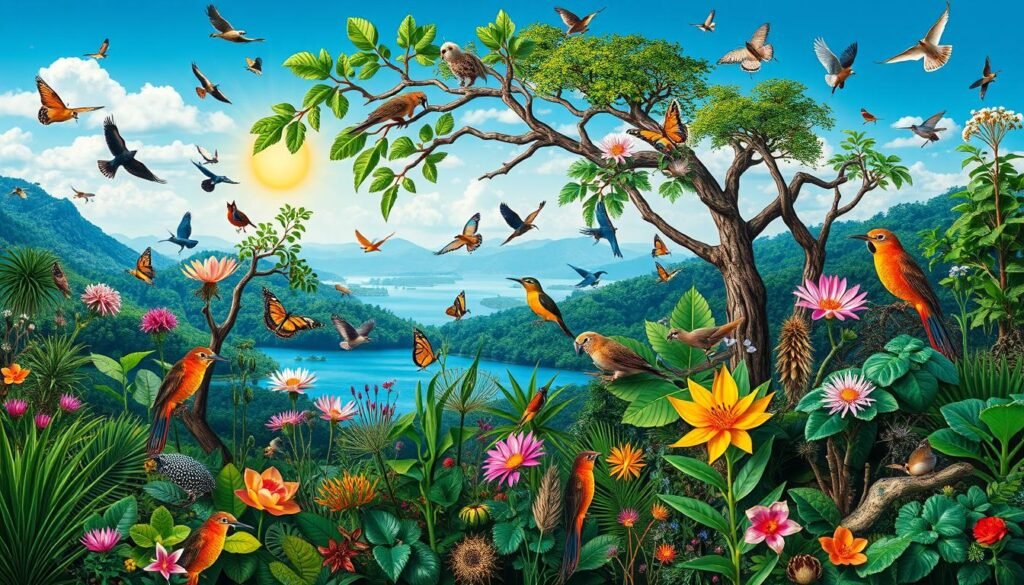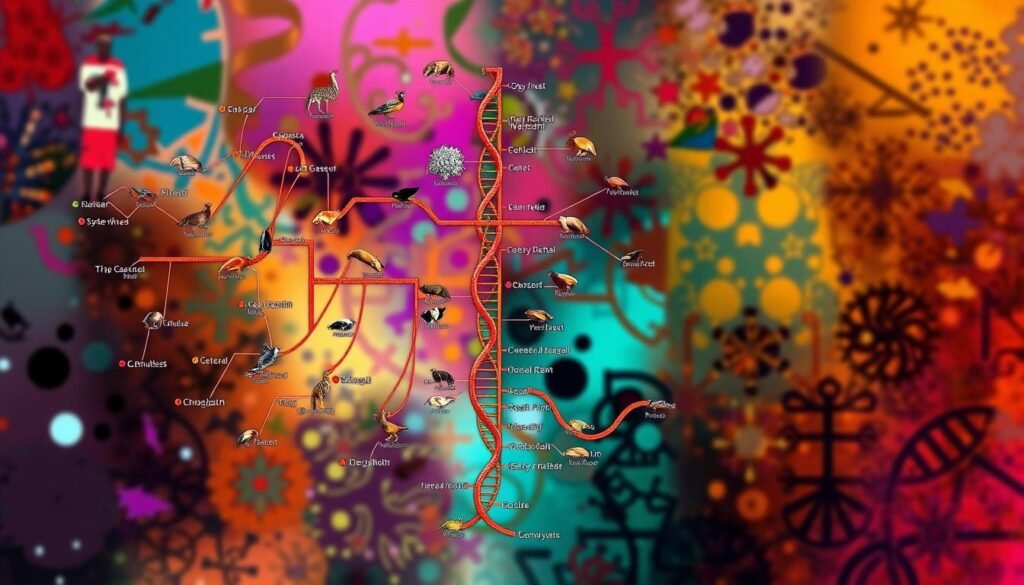Have you ever thought about how genetics can lead toward extinction? This question is key to understanding inbreeding depression. It’s a problem seen in animals, plants, and humans. Inbreeding depression causes offspring of close relatives to have lower survival and fertility. This shows how important genetic health is.
Looking into the genetics of inbreeding depression tells us a story. It’s about bad mutations that build up when there isn’t much genetic variety. Combining old genetic studies with new methods shows how crucial genetic diversity is. Keeping diversity up helps keep populations healthy. So, studying inbreeding depression helps us save species and care for our ecosystems.
Key Takeaways
- Inbreeding depression affects survival and fertility of closely related offspring in various species.
- It is primarily caused by the presence of recessive deleterious mutations.
- Managing genetic diversity is essential for healthy populations.
- Inbreeding can lead to an ‘extinction vortex’ by increasing harmful homozygosity.
- Understanding the dynamics of inbreeding is crucial in crop breeding and conservation efforts.
What is Inbreeding Depression?
Inbreeding depression is when offspring from closely related parents show a drop in health and ability to have babies. This issue arises because of harmful genes coming together. As a family’s gene pool gets smaller, these negative traits are more likely to appear.
Both plants and animals can suffer from inbreeding depression. Research on Delphinium nelsonii found that inbreeding led to less fit and shorter-lived offspring. In Isle Royale National Park, the gray wolf population could have died out due to inbreeding, which lowered their survival and birth rates.
The impact of inbreeding depression changes with each species. Hermaphroditic species seem to handle inbreeding better than those that mate with others. For example, the nematode Caenorhabditis remanei is badly affected by inbreeding, unlike C. elegans. The effects can be lessened by things like selecting for strong genes or genetic differences in chromosome numbers.
Keeping ecosystems healthy requires understanding inbreeding depression. Isolated groups with few genes are in greater danger. Wildlife experts sometimes bring in new genes to help. This helps keep populations diverse and far from the harms of inbreeding.
To learn more about how genes play a role in inbreeding depression, check out this resource.
The Impact of Inbreeding Depression on Population Health
Inbreeding depression seriously affects population health. This issue is mostly seen in small or isolated groups. Here, related individuals have a higher chance of mating. A study observed that inbreeding led to lower fitness levels in various populations. This shows how inbreeding can harm a population’s health.
Fast inbreeding hurts population fitness more than slow inbreeding. This fact stands out in smaller groups. One example is the sihek, or Guam kingfisher. Inbreeding depression harmed its survival at many stages of life. It shows how inbreeding threats a species’ existence.
As inbreeding grows, a small population’s overall health declines through generations. This trend highlights the importance of genetic diversity for population health. Studies link better fitness with greater genetic variation. Diverse genetics help fight the negative effects of inbreeding.
Hybridization, or mixing different genetic populations, can help. It may reduce inbreeding’s bad effects and boost health. Hybrid offspring often are stronger. So, fighting inbreeding depression is key for managing and protecting populations.

Genetic Diversity and Its Role in Mitigating Inbreeding Depression
Genetic diversity is vital for the health and survival of species. For example, apples show strong resilience against inbreeding depression because of their genetic variation. These variations give us apples that vary in flavor and color.
Inbreeding depression can seriously harm the health of offspring. It often leads to lower rates of survival. Species with little genetic variation struggle more with environmental changes. This struggle may lead to their extinction.
To illustrate, Jumellea rossii has a high genetic diversity, which helps it survive threats. This resilience is due to factors like habitat loss and the risk of being over-collected.
Conversely, Jumellea fragrans shows lower genetic diversity and doesn’t suffer from inbreeding depression. This shows how essential genetic diversity is for the life of plant species.
Isolated populations losing genetic diversity can benefit from genetic rescue. This conservation method saved the Florida panther from extinction by increasing its genetic diversity.
It’s crucial to focus on boosting genetic diversity in conservation efforts. Understanding breeding and mating systems can help species adapt and flourish amidst environmental changes.

| Species | Mating System | Allelic Richness (AR) | Expected Heterozygosity (He) | Inbreeding Depression |
|---|---|---|---|---|
| Jumellea rossii | Mixed | 8.575 | 0.673 | Present (δ = 0.66) |
| Jumellea fragrans | Outcrossing | 4.983 | 0.492 | None observed |
Discovering Deleterious Alleles: The Hidden Threats
Deleterious alleles can harm the health and survival of small populations. These bad genetic variations are hard to spot because they are recessive. Natural selection usually gets rid of the dominant bad alleles, but recessive ones build up. This buildup leads to serious health problems and fitness decline, known as inbreeding depression.
The gray wolf population on Isle Royale shows this clearly. For over 70 years, their numbers dropped to about 10-50. By 2018, only two wolves were left. The arrival of a new wolf in 1997 introduced many bad recessive alleles. This led to 34 offspring at first. But soon, severe inbreeding happened, showing the risks and benefits of trying to fix genetic problems.
It’s key to understand deleterious alleles to fight inbreeding depression. Conservation used to focus on increasing genetic diversity. Now, studies show it might be better to reduce bad genetic variations. This new strategy could help, especially in small populations that have already faced inbreeding.
Conservationists work hard to prevent extinction in small, isolated groups by targeting deleterious alleles. Learning more about these genetic risks can improve how we save species. To dive deeper into this topic, check out a detailed study here.
The Inbreeding Coefficient: A Measure of Genetic Relatedness
The inbreeding coefficient tells us how likely it is that two alleles are identical by descent. It’s crucial for understanding how related individuals are in a group. When this number is high, it means there’s a bigger chance of genetic problems due to inbreeding depression. This is especially true in groups with little genetic variety.
In studies, Japanese Black cattle showed a big decrease in population size. From 1985 to 1997, their effective population size dropped to 17.2. At the same time, the inbreeding coefficient went up to 5.4%. These numbers show how the health of a population can decline as inbreeding increases.

Genomic predictions add another layer to this issue. For dairy cattle in both Dutch-Flemish and North American herds, the inbreeding rates go up every year. Using genomes to calculate inbreeding gives numbers between 0.33 and 0.94. These figures agree well with traditional pedigree estimates, helping us gauge genetic health.
The impact of inbreeding depression varies across different groups. The pedigree-based inbreeding coefficient impacted reproductive traits significantly. This shows the inbreeding coefficient affects more than just numbers. It has real effects on managing genetics in agriculture. To combat inbreeding, there’s a push for better management practices to keep genetic diversity up and avoid inbreeding problems.
In the end, looking at the inbreeding coefficient gives us valuable insights into genetic relatedness. It’s key for programs that aim to keep animals healthy genetically. They work to make sure populations remain strong and diverse.
Evolutionary Biology Perspectives on Inbreeding Depression
In evolutionary biology, inbreeding depression is a big challenge. It also gives us a chance to learn about natural selection and how populations change. The rise of homozygotes and the shortage of heterozygotes from inbreeding show hidden harmful mutations. These mutations can impact different species, like Drosophila melanogaster, mice, and humans. Studies have found that inbreeding decreases the chances of survival, affecting mortality rates at different ages.
Research shows inbreeding causes a baseline mortality rate to go up by 0.046 for each day of life. This shows how evolution influences who mates with whom and how they reproduce. Genes that hurt the species more at later life stages show the effects of reduced natural selection. This contributes to the problem of inbreeding depression.
The theory of mutation accumulation suggests inbreeding hits harder at older ages. The antagonistic pleiotropy theory, however, sees no change with age. In groups with constant population sizes, inbreeding varied based on the number of original founders. This was observed in groups with 4 and 20 founders, showing different levels of genetic variety.
About 10-15% of flowering plants mostly fertilize themselves. These plants have to overcome a big reproductive hurdle due to their inbreeding. They might pass on more genes but do a worse job spreading pollen compared to those that cross-fertilize. This balances the pros and cons of selfing versus cross-breeding.
Rapid changes in climate add complexity to inbreeding depression. Environmental stress makes the downsides of inbreeding worse, raising the risk of extinction for some populations. Understanding these effects across various conditions and species is crucial. It shows how inbreeding depression changes with the environment, species type, and genetics.
Research on inbreeding depression and environment should look into the genetic details of these interactions. This is key to keep genetic diversity and help populations stay strong.
For more info on inbreeding, check out the deep dive in evolutionary biology sources.
Mating Systems and Their Influence on Inbreeding Depression
Mating systems play a big role in genetic health. In places where different plants or animals mix genes, diversity blooms. This range helps fight inbreeding depression, lowering the risk of inheriting bad traits. Studies looking at Linanthus bicolor and Linanthus jepsonii are revealing. The former had a low outcrossing rate under 0.075, while the latter varied from 0.104 to 0.300.
These findings shed light on why mating choices matter for genetic wellbeing. Across the board, inbreeding depression stayed below 0.23, but some groups were more at risk. Take L. jepsonii for instance; it showed a big drop in pollen fertility from inbreeding, unlike L. bicolor.
The way species mate can trigger inbreeding depression. When creatures self-fertilize or don’t mix much, inbreeding upsides. This inbreeding leads to more relatives sharing the same genes, making inbred offspring less fit than outbred ones. Recognizing these patterns helps save species through smarter breeding.
For mental health insights, check out debunking depression myths. More knowledge on this topic encourages open talks in communities. It supports folks in dealing with issues like genetic health challenges from mating systems.
Genetic Rescue: Solutions to Combat Inbreeding Depression
Genetic rescue is a key conservation strategy aimed at fighting inbreeding depression. It increases genetic diversity in populations that need help. By bringing in unrelated individuals from different groups, bad genes that come from inbreeding decrease. The success of the Florida panther, greater prairie chicken, and pink pigeon shows how effective this method can be. It has helped these species grow in number and health.
However, genetic rescue is not often used. A study found that only 11 out of 222 threatened species in the U.S. include it in their recovery plans. Few have tried assisted migration, leaving much room for expansion. Since 2015, there have been 20 successful cases worldwide. Identifying more species that could benefit from genetic rescue could offer new hopes for conservation.
Experts in conservation biology stress the importance of improving gene flow and genetic rescue. They recommend guidelines to help managers avoid risks like outbreeding depression. These steps, supported by genetic research from creatures like the pink pigeon and Swedish adder, are critical for the future of certain species. For more information and evidence, check out this resource.